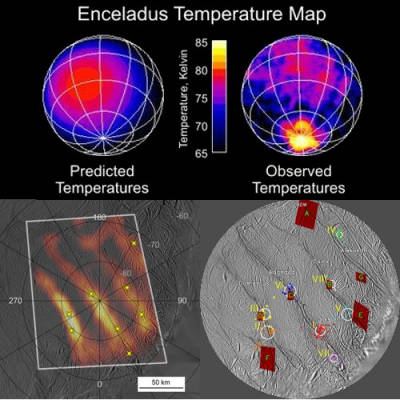An Enceladus-Saturn Electrical Connection?
08/11/08
The Cassini team is preparing to probe Enceladus’ south pole so they can sample its plumes and take high resolution photos of the “tiger stripe” fractures. Will they pin down the sources of the plumes and the polar hot spots, or will they find evidence supporting the Electric Universe model, or both?

Top: Enceladus temperature map Credit:
NASA/JPL/GSFC.
Bottom left: Jet spots in tiger stripes. Credit:
NASA/JPL/Space Science Institute.
Bottom right: Enceladus jet sources. Credit:
NASA/JPL/Space Science Institute.
[Click on main image to enlarge, on position descriptions for individual enlargements,
and on credits to go to the source]
In a recent
press release , it was announced that Cassini would fly within 30 miles (50 kilometers) of Enceladus’ south pole in order to more closely observe several vexing features.
The main objective is to get high resolution images of the “tiger stripe” fissures, and the regions at or around several hot spots and jets spewing a mix of interesting materials into space. A further objective will be to determine the size of ejected ice grains and more accurately assess the ejecta’s composition. Another objective is to get a better temperature map of the region in order to assess if any of the tiger stripes is significantly warmer than the others and try to figure out whether current theories about the origins of the tiger stripes, hot spots, jets and ejecta are correct.
However, those who have been keeping up with findings about not only Enceladus, but other moons (such as those in the Jovian system) and happenings in the solar system in general have some other suggestions of what might be found, should NASA endeavor to investigate further.
In a TPOD entitled “
The Hot Poles of Enceladus ,” it was pointed out that:
The NASA press release reports that [the first image (above)] “startled” scientists. The hot spot around Enceladus’ south pole is “very difficult to explain if sunlight is the only energy source heating the surface.” The only other likely heat source available to conventional theorists is internal heat, but they are “unsure how the internal heat reaches the surface.”
The TPOD goes on to say:
In the electric view, the warm rilles and hot pole are electrically heated. The water vapor from the rilles is being electrically “machined” from them. A similar process should be occurring at the north pole, where the electric current flowing through Enceladus returns to Saturn’s sheath circuit.
NASA scientists have noticed the “bending” of Saturn’s magnetic field around Enceladus “due to electric currents generated by the interaction of atmospheric particles and the magnetosphere of Saturn.” But their blind spot with regard to plasma behavior leads them to insist that the electric currents “don’t do anything.”
While this may seem on its face to be an extraordinary claim, it is not apparently without merit! But, the reasoning requires a little explanation.
Taking a step back for a more generalist view, there are certain indicators that Enceladus may be embroiled in an electrical interaction with Saturn. Strong indirect evidence comes in the form of Io’s interaction with Jupiter, and vice versa.
In 2001, a
NASA news release made several remarks relevant to the discussion. It provides several clues necessary to piece the puzzle together. It seems that in the process of investigating Io, they ran across several electrical processes.
It appears they’ve discovered electric currents flowing above several areas they’ve deemed to be “volcanic.”
Galileo detected electrical currents flowing along magnetic field lines above two areas of volcanic activity on Io, Kivelson said. Material shot high from eruptions is apparently affecting conductivity more than 100 kilometers (about 60 miles) above the surface.
"If this is the mechanism that's producing the currents, it may help us in the search for active plumes," she said.
If NASA scientists were to ask proponents of the Electric Universe model how the “volcanoes” were formed and what the electric currents discovered over them have to do with the issue, they would get a considerably different answer rooted in the fields of plasma physics and electrical engineering.
Specifically, they would most likely refer to the 2001 discovery as confirmation of a
1988 paper suggesting that the “volcanoes” are not in fact volcanic, but rather are the effect of electrical discharge machining (EDM) caused by the electric currents flowing between Jupiter and Io. The proverbial “smoking gun.”
They might also say that the NASA scientists had it precisely backward. It’s not that the “volcanoes” somehow initiate the electrical interaction by spewing ionized materials, but that that the currents between Jupiter an Io are the active party in initiating the “volcanoes” (electrical machining of the surface). Which may also explain why some of the volcanoes appear to have moved over 80 kilometers since we started observing them years ago. Actual volcanoes on Earth are generally non-migratory.
In another interesting set of revelations, the news release also talks about the “roar of acoustic waves” at both Io’s north and south poles. However, as we’ll see, their “acoustic wave” description appears to be incorrect.
A great roar of acoustic waves near the north and south poles of Jupiter's moon Io shouts about the power of the volcanic moon.
[…]
"You hear a whistling sound from Jupiter's radio emissions, then, just when you go over the pole, you hear a tremendous roar that starts abruptly, then stops abruptly," Gurnett said. "It's like the noise from a huge electrical power generator." Io actually generates as much wattage as about 1,000 nuclear power plants.
The region of increased density is where electrons and ions come up from Io's tenuous atmosphere and follow a "flux tube" where field lines from Jupiter's strong magnetic field intersect Io. In a 1999 flyby of Io, Galileo had provided some indication of the higher density over the moon's poles. This year's two Io flybys were the first to show that those denser areas coincide with the magnetic-field flux tube, Gurnett said.
In their own words, “’It’s like the noise from a huge electrical generator.’ Io actually generates as much wattage as about 1,000 nuclear power plants. ” The truth will set them free! If they allow it to… In essence what they’ve discovered is, rather than simple acoustic waves, electric currents flowing along magnetic field lines (“Birkeland currents” or “field-aligned currents”) and interacting with Io’s poles. Strangely enough, this should not be unfamiliar to NASA.
It has been known since March of 1979 (when Voyager 1 flew through the Io-Jupiter electrical connection) that Jupiter and Io are involved in an electrical exchange of approximately
1 million Amperes . A more recent article also attributes a wattage of approximately
2 terawatts (2 trillion watts) to the exchange. A back of the envelope calculation (volts = watts / amps) thus also yields an estimated 2 million volt potential difference between Jupiter and Io (if the estimated amps and watts of the interaction are accurate).
In December 2000, a
Hubble news release stated that several moons have a “footprint” in Jupiter’s aurora, including (at a minimum) Io, Ganymede and Europa. It would be unsurprising to find that other moons may have very similar auroral footprints and ties to the electrical circuitry of the larger planet they orbit.
Further, an even more recent
news release notes that not only are there footprints in one hemisphere’s aurora, but there are footprints on the other hemisphere as well. They go on to speculate that Io is embroiled in an
electron beam traveling from one hemisphere of Jupiter to the other.
And, what is an electron beam, if not an electric current? An electron beam is, after all, a bulk flow of negatively charged electrons in the same direction (fitting the definition of an “electron current,” as opposed to a “conventional current” which concerns the flow of positively charged particles).
It seems intuitive then to assume that, if Io is connected to an “electron beam” or a “flux tube” and has a footprint in Jupiter’s aurora, other moons with similar footprints in Jupiter’s aurora are also likely embroiled in such an “electron beam” or “flux tube,” which would have an equally electrical character.
We might then expect that moons involved in such an exchange with the larger bodies they orbit would have significant activity at their poles that would not be expected under gravity-only assumptions.
In fact, that is precisely the case with Enceladus! As noted at the beginning of this commentary, when scientists compared their predicted models of Enceladus’s temperature profile to the actual observed temperature profile, they were in for a
shocking revelation .
Based on data from previous flybys, which did not show the south pole well, team members expected that the south pole would be very cold, as shown in the left panel. Enceladus is one of the coldest places in the Saturn system because its extremely bright surface reflects 80 percent of the sunlight that hits it, so only 20 percent is available to heat the surface. As on Earth, the poles should be even colder than the equator because the sun shines at such an oblique angle there.
What they found was that rather than being the extremely cold pole expected under gravity-and-sunlight-only assumptions, Enceladus’ pole was warmer than the equatorial region (though still quite cold)!
For those familiar with other verified Electric Universe predictions, this surprise about an extremely hot pole should sound quite familiar. In fact, it was the same shocked reaction scientists gave when Wal Thornhill’s experimentum crucis at Saturn’s north pole was
confirmed (rather than being the cold anti-sunward pole expected by scientists, the north pole of Saturn was just as hot as the pole facing the sun, despite having been in Saturnian winter for several years). Granted most scientists probably had not and still have not heard of the prediction and even fewer realize it has been confirmed…
In a similar vein to the Saturnian dual hotspots, Venus has double-eyed vortices at both poles, which Wal Thornhill has also explained via electrodynamics.
To oversimplify, the polar features of Venus, Saturn, Enceladus, Io, appear to be due to the propensity of electric currents to flow in at the poles (following magnetic field lines) and may have something in common with a
Faraday disk in that regard.
It’s interesting then that the majority of activity on Enceladus appears to be clustered around the pole. The pole is considerably warmer than the equator. The “tiger stripes” are unexpectedly
warmer than the surrounding terrain. The “jets” feeding Enceladus’
plumes appear to be
clustered in or near the tiger stripes.
Another point to ponder is the notion that Enceladus’ plumes “taste” a lot like comets. Apparently, when looking at the
composition of the plumes, the results were rather similar to those coming from comets. Enough so, that mission scientists remarked as such in a March
news release.
"A completely unexpected surprise is that the chemistry of Enceladus, what's coming out from inside, resembles that of a comet," said Hunter Waite, principal investigator for the Cassini Ion and Neutral Mass Spectrometer at the Southwest Research Institute in San Antonio.
[…]
"Enceladus is by no means a comet. Comets have tails and orbit the sun, and Enceladus' activity is powered by internal heat while comet activity is powered by sunlight. Enceladus' brew is like carbonated water with an essence of natural gas," said Waite.
It probably depends on who you ask how you define a comet, or at least what processes are involved in the production of the constituent materials found in and around comets’ comas and tails.
The Electric Universe model regards comets as a crux for understanding some of the electric nature of the solar system. More specifically, the
Electric Comet model posits that comets are not the “dirty snowball” or “icy dirtball” of legend. In fact there is little ice in or on comets. Wal Thornhill explains the process as that of electrochemical sputtering and recombination from oxygen-rich materials on the asteroid’s solid rocky surface. Liberated oxygen then recombines with one or more hydrogen to form the hydroxyl radicals and H2O found in comets’ comas.
Of late, the dirty snowball model looks more and more like it’s dead as a doornail. Probes have failed to find water in comets tails, instead finding dust and crystals that can only be formed under high temperatures and pressures. Turning space telescopes toward comets as they broke apart failed to yield any of the expected water or volatiles. Recently, an independent researcher unaffiliated with proponents of the Electric Universe proposed
a highly similar mechanism (chemical sputtering) for the production of hydroxyl radicals and water in the atmosphere and tail of Mercury!
“What has one to do with the other?” one might ask.
If Enceladus is in fact the subject of electric currents from Saturn machining or otherwise acting on its surface (similar to the interaction between Io and Jupiter), would it not stand to reason that a similar process to that of comets may be generating similar results? Specifically, if the Electric Comet model is accurate, and the solar domain is an electrically active place, might not common result come from common causes? The local production of OH and H2O in comets’ comas or in Mercury’s atmosphere, and Enceladus’ cometary plumes may all be sourced to electrical interactions machining or sputtering materials from their surfaces.
If NASA is interested in investigating further, they may wish to look for signatures of electric currents near the pole(s) of Enceladus. Likewise, the radio noise or “acoustic waves” similar in nature and source to those found at Io. Such electric currents may also have some specific magnetic signature. We should know by now that electric currents and magnetic fields are flip sides of the same coin and intimately related, as noted in a
prior Thunderblog .
It will be interesting to see what new results Cassini yields and whether it makes or breaks the case for either side of the debate.
Michael Gmirkin.
Permalink to this article.
Public comment may be made on this article on the
Thunderbolts Forum/Thunderblogs (free membership required).
|

Michael Gmirkin is a technology enthusiast with a keen interest
in exploring the electrical nature of the universe.
My Archives
Chronological Archives
Archives by Author
Archives by Subject
Thunderblogs home
|





